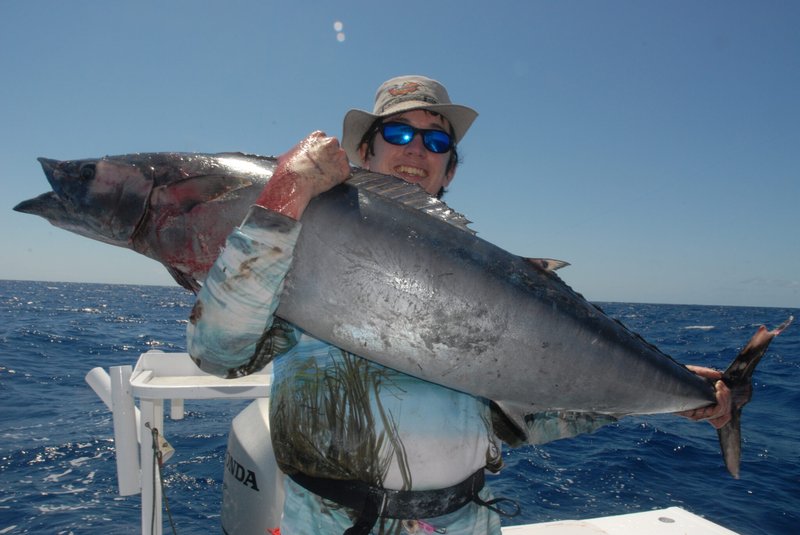
When you think of a speedy swimmer in the ocean, the Wahoo Fish is likely at the top of the list. Known for its sleek body and incredible speed, this fish is a true marvel of the marine world. It belongs to the mackerel family and can be found in tropical and subtropical waters across the globe. Imagine a fish that can dart through the water like a torpedo — that’s the Wahoo for you!
This fish isn’t just fast; it’s also well-adapted to its environment. With striking colors and a streamlined shape, the Wahoo is built for speed and agility. You might encounter them while deep-sea fishing or even while snorkeling in warm ocean waters. Their fascinating behavior and unique characteristics make them a popular subject of interest for marine enthusiasts and casual observers alike. So, let’s dive in and explore this incredible creature further!
Physical Characteristics of Wahoo Fish
The Wahoo Fish can be easily recognized by its long, slender body and amazing coloration. Typically, they sport a beautiful blue dorsal side that transitions into a silvery-white belly, adorned with vertical stripes that can sometimes be quite striking. An adult Wahoo can reach lengths of up to 8 feet and weigh more than 180 pounds, though the average size is usually between 30 to 60 pounds.
One of their most notable features is their impressive jaw, which is equipped with sharp, pointed teeth designed for grasping slippery prey. Their fins are also a sight to behold; the long dorsal fin can often create a dramatic silhouette as they swim. The combination of their size, speed, and formidable teeth makes them a top predator in their habitat. Imagine spotting one of these beauties slicing through the waves — it’s a breathtaking sight!
Coloration and Patterns
The coloration of Wahoo Fish is not just for show; it serves a purpose. The dark blue on top helps them blend in with the ocean depths when viewed from above, while the lighter underside camouflages them against the bright sky when seen from below. This dual camouflage technique allows the Wahoo to stalk its prey effectively, stealthily approaching fish that are unaware of the predator lurking nearby.
Additionally, the vibrant stripes can help in communication and recognition among other Wahoo fish. Some researchers believe that these patterns may even play a role during mating rituals or social interactions. Each Wahoo possesses a unique pattern, much like a fingerprint, making them not only functional but also aesthetically fascinating!
Habitat and Distribution
The Wahoo Fish is found in warm, open waters around the world. They prefer the deep ocean but can also be found near the surface, especially where prey is plentiful. Their range includes the Atlantic, Indian, and Pacific Oceans, often found in waters with temperatures between 70°F to 85°F.
These fish typically inhabit areas with structure, such as underwater ridges, reefs, and floating debris, where they can hide and ambush their prey. The Wahoo is known for its migratory behavior; they can travel great distances in search of food, often following schools of smaller fish like mackerel and sardines. The excitement of chasing these fast fish makes them a favorite among sport fishermen!
Social Behavior
Wahoo Fish can be seen both alone or in small groups, depending on various factors, including food availability and mating conditions. Although they are solitary hunters, they tend to be more social when young. Young Wahoo often form schools, which provides safety in numbers from larger predators.
While hunting, Wahoo are known for their surprising agility. They can accelerate rapidly, throwing their prey off-guard. This hunting method is one reason why they are such thrilling targets for anglers. Just picture it: you cast your line, and with luck, you might reel in one of these quick fish. It’s an adrenaline rush like no other!
Behavior and Feeding Habits
Wahoo Fish are *extremely* versatile eaters. As carnivores, they primarily feed on smaller fish, squid, and even crustaceans. They are known for their incredible speed, which allows them to pursue and capture their prey efficiently. Their sharp teeth and fast swipes through schools of fish make hunting seem almost effortless.
To put it simply, fishing for Wahoo requires more than just luck. You’ll need to use the right bait and techniques to emulate their natural prey — something that really gets the heart racing! Many anglers recommend using lures that mimic the swift movements of smaller fish or employing live bait to attract these formidable predators.
Speed and Hunting Technique
With their streamlined bodies, Wahoo Fish can swim at speeds of up to 60 miles per hour. This astonishing speed makes them one of the fastest fish in the ocean. When hunting, they often rely on surprise — darting in and out of schools of fish to catch their meals before the prey can react.
Think of it like a sports car gunning it down a straight highway. The Wahoo uses its speed not only for hunting but also to evade larger predators, like sharks. This advantage makes them a unique and fascinating part of the marine ecosystem, showcasing the balance of predator and prey.
Reproduction and Lifespan
The breeding season for Wahoo typically occurs in warmer months, although it can vary depending on the region. Female Wahoos can spawn multiple times during the season, releasing thousands of eggs into the water. This method of spawning increases the chances of survival for their offspring, as not all eggs will hatch and survive to adulthood.
Lifespan: In the wild, Wahoo can live for about 3 to 5 years, though some individuals might reach up to 7 years. While they grow rapidly during their early years, their growth rate tends to slow down as they age. Understanding their life cycle is crucial for conservation efforts, particularly in regions where overfishing is a concern.
Conservation Status
Currently, the Wahoo Fish is classified as a species of least concern by the IUCN. However, overfishing remains a significant threat to their populations in certain areas. Sustainable fishing practices are vital to ensure that these incredible fish continue to thrive for generations to come. Many organizations are working to promote awareness and implement regulations to protect Wahoo populations.
As consumers, we can also make a difference by choosing sustainably harvested seafood. Being mindful of our choices helps to maintain the beauty of ocean ecosystems where the Wahoo and many other creatures call home.
Fun Facts About Wahoo Fish
Wahoo are not just remarkable for their speed and hunting prowess; they have some interesting traits worth noting! For starters, they can change colors slightly based on their mood or health, a fascinating feature that adds to their dynamic presence in the ocean. Additionally, Wahoo are known to jump out of the water when caught, putting on quite a show for anglers and spectators alike!
Another fun fact is that Wahoo can be quite curious. They have been observed swimming alongside boats, possibly attracted to the sounds or movements. This behavior can provide a unique opportunity for snorkeling enthusiasts to observe them in their natural habitat.
Wahoo in Culinary Context
Let’s not forget that Wahoo fish is also a popular choice for seafood lovers! Its firm, white flesh is known for being mild and sweet, making it perfect for grilling, baking, or even sushi. The health benefits are real too; Wahoo is a great source of lean protein and omega-3 fatty acids, which contribute to heart health.
Cooking Wahoo can be an adventure on its own. Many chefs enjoy pairing it with bold flavors, like tropical fruits or spicy marinades, to accentuate its natural taste. Whether you’re dining at a fancy restaurant or hosting a backyard barbecue, serving up some Wahoo is sure to impress your guests!
FAQ
What is the best way to catch Wahoo Fish?
The best way to catch Wahoo is by using trolling techniques with lures that mimic the movement of smaller fish. Speedy and agile, Wahoo respond well to fast-moving baits. Many anglers recommend using rigged baits like ballyhoo or artificial lures that can be trolled at high speeds. Don’t forget to be patient and ready for a strong fight once you hook one!
Are Wahoo Fish dangerous to humans?
Wahoo Fish are not known to be aggressive towards humans. They are more likely to flee than confront, but like any wild animal, it’s essential to respect their space. When fishing for Wahoo, be cautious of their sharp teeth during handling, as they can cause injury if not treated carefully.
How do Wahoo Fish adapt to their environment?
Wahoo Fish have several adaptations that help them thrive in their warm, open-water environments. Their streamlined bodies allow them to swim quickly, while their coloration provides camouflage against predators. Their specialized teeth are perfect for catching slippery prey, making them skilled hunters in the ocean.
Can Wahoo Fish be found in freshwater?
No, Wahoo Fish are strictly saltwater fish and are not found in freshwater environments. They inhabit tropical and subtropical seas, preferring deeper waters where they can hunt for smaller fish and squid. Saltwater is essential for their survival and growth.
What do Wahoo Fish eat?
Wahoo Fish primarily feed on smaller fish, squid, and crustaceans. They are fierce predators, using their speed and sharp teeth to catch their prey. Hunting in bursts of speed, they can quickly close in on schools of fish, making them efficient hunters in their ecosystem.
How long do Wahoo Fish live?
Wahoo Fish typically live for about 3 to 5 years in the wild. Some individuals may reach up to 7 years, but their lifespan is generally shorter due to predation and fishing pressures. Understanding their lifespan helps in conservation efforts to ensure their populations remain stable.
Are Wahoo Fish good to eat?
Yes, Wahoo Fish is considered excellent table fare! Its firm, white flesh has a mild and slightly sweet flavor, making it versatile for different cooking methods, such as grilling or baking. Loaded with lean protein and omega-3 fatty acids, it’s a healthy choice for seafood lovers.
How fast can Wahoo Fish swim?
Wahoo Fish are incredibly fast, capable of reaching speeds of up to 60 miles per hour. This remarkable speed is one of the reasons they are such effective predators, as they can swiftly chase down and capture their prey.
What is the scientific name of the Wahoo Fish?
The scientific name of the Wahoo Fish is Acanthocybium solandri. This species is part of the mackerel family and is well-known among fishermen for its speed and culinary value.
How do Wahoo Fish reproduce?
Wahoo Fish reproduce by spawning, where females release thousands of eggs into the water during warmer months. This method enhances the likelihood of survival for the offspring, as many eggs may not hatch or survival rates can be low in nature. This reproductive strategy is crucial for maintaining their populations.
Where can I find Wahoo Fish?
Wahoo Fish can be found in warm, open waters around the world, including the Atlantic, Indian, and Pacific Oceans. They prefer deeper waters but can also be seen near the surface, often around underwater structures or floating debris where prey is abundant.
What threats do Wahoo Fish face?
While Wahoo Fish are currently classified as of least concern, they face threats such as overfishing and habitat degradation. Sustainable fishing practices are essential to protect their populations, and conserving their marine environment is crucial for their future.

